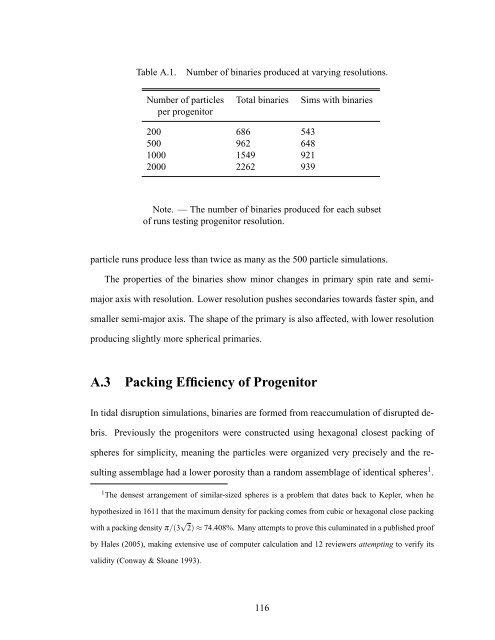- Page 1 and 2:
AbstractTitle of Dissertation:Formi
- Page 3 and 4:
Forming Binary Near-Earth Asteroids
- Page 5 and 6:
PrefaceMuch of the work in this dis
- Page 7 and 8:
AcknowledgementsI would not have ma
- Page 9 and 10:
2.3 Results and Discussion . . . .
- Page 11 and 12:
List of Tables1.1 Binary NEA proper
- Page 13 and 14:
4.8 Percentage of migrated binaries
- Page 15 and 16:
of the system mass M by way of Kepl
- Page 17 and 18:
the largest lightcurve amplitudes o
- Page 19 and 20:
1.1.3 Binary Main-Belt asteroidsRec
- Page 21 and 22:
Lightcurve discoveriesA lightcurve
- Page 23 and 24:
Figure 1.1: (Top) The primary rotat
- Page 25 and 26:
1.2.1 CaptureIn this scenario two a
- Page 27 and 28:
ever, understanding the mechanism i
- Page 29 and 30:
off the equator or off one end of a
- Page 31 and 32:
3 Denotes a secure result with no a
- Page 33 and 34:
nostic.Recent results have demonstr
- Page 35 and 36:
another intermediate source of NEAs
- Page 37 and 38:
1.5.2 Rubble pilesThe evidence for
- Page 39 and 40:
Chapter 2Formation of Binary Astero
- Page 41 and 42:
∼ 60%, making a bulk density of
- Page 43 and 44:
shedding mass and distorting prior
- Page 45 and 46:
Figure 2.3: Snapshots of a tidal di
- Page 47 and 48:
Figure 2.4: Normalized probability
- Page 49 and 50:
Figure 2.5: Normalized probability
- Page 51 and 52:
Figure 2.6: (a) Satellite eccentric
- Page 53 and 54:
various complications of measuring
- Page 55 and 56:
etween ω pri and L bin ), with clo
- Page 57 and 58:
prolate-like), the oblate-like bodi
- Page 59 and 60:
Figure 2.9: Plots comparing T-PROS
- Page 61 and 62:
Figure 2.10: Comparison of S-class
- Page 63 and 64:
2.3.5 Triples and hierarchical syst
- Page 65 and 66:
a/R pri based on a simple conversio
- Page 67 and 68:
Figure 2.13: The eccentricity dampi
- Page 69 and 70:
Main Belt. Work by Chauvineau & Far
- Page 71 and 72:
(1992), with a target range of slig
- Page 73 and 74:
The observations were made from the
- Page 75 and 76:
peaked period, with a lower signifi
- Page 77 and 78: and suggests that it is possibly a
- Page 79 and 80: fit for the period of the lightcurv
- Page 81 and 82: Table 3.2.Orbital, physical and lig
- Page 83 and 84: Figure 3.2: Asteroid lightcurves.70
- Page 85 and 86: Figure 3.4: Asteroid lightcurves.72
- Page 87 and 88: 3.4.4 Spin and shape properties amo
- Page 89 and 90: Figure 3.7: The lightcurve amplitud
- Page 91 and 92: Typically observations of eclipse o
- Page 93 and 94: Chapter 4Steady-State Model of the
- Page 95 and 96: values between 0.2-0.6. There is on
- Page 97 and 98: asteroids in the Main Belt is suffi
- Page 99 and 100: Figure 4.2: Percent of surviving NE
- Page 101 and 102: 4.1.3 Binary evolutionBasic stabili
- Page 103 and 104: Table 4.1.Lifetimes for binary NEAs
- Page 105 and 106: which means it should have a critic
- Page 107 and 108: Figure 4.4: The total number of bin
- Page 109 and 110: the original eccentricity distribut
- Page 111 and 112: Figure 4.6: Properties of the binar
- Page 113 and 114: Figure 4.8: Binary percentage for m
- Page 115 and 116: Figure 4.9: Effects of tidal evolut
- Page 117 and 118: quickly altered, or involved in bin
- Page 119 and 120: tidal disruption. However, the impl
- Page 121 and 122: Chapter 5ConclusionsA general concl
- Page 123 and 124: small additions to the angular mome
- Page 125 and 126: cently this large pool of observers
- Page 127: differences in results when a lower
- Page 131 and 132: Thus the reaccumulated bodies in th
- Page 133 and 134: of 2.2 h observed is significantly
- Page 135 and 136: Benner, L. A. M., Nolan, M. C., Ost
- Page 137 and 138: V7.0:LCREF TAB, 35, 4Harris, A. W.,
- Page 139 and 140: Storrs, A. D., Close, L. M., & Mena
- Page 141 and 142: 122Pravec, P., Kušnirá, P., Hicks
- Page 143 and 144: Shepard, M. K., Schlieder, J., Nola












